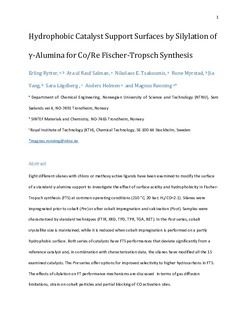| dc.contributor.author | Rytter, Erling | |
| dc.contributor.author | Salman, Ata ul Rauf | |
| dc.contributor.author | Tsakoumis, Nikolaos | |
| dc.contributor.author | Myrstad, Rune | |
| dc.contributor.author | Yang, Jia | |
| dc.contributor.author | Lögdberg, Sara | |
| dc.contributor.author | Holmen, Anders | |
| dc.contributor.author | Rønning, Magnus | |
| dc.date.accessioned | 2017-12-05T10:06:49Z | |
| dc.date.available | 2017-12-05T10:06:49Z | |
| dc.date.created | 2017-12-04T08:52:54Z | |
| dc.date.issued | 2018 | |
| dc.identifier.citation | Catalysis Today. 2018, 299 20-27. | nb_NO |
| dc.identifier.issn | 0920-5861 | |
| dc.identifier.uri | http://hdl.handle.net/11250/2469223 | |
| dc.description.abstract | Eight different silanes with chloro or methoxy active ligands have been examined to modify the surface of a standard γ-alumina support to investigate the effect of surface acidity and hydrophobicity in Fischer-Tropsch synthesis (FTS) at common operating conditions (210 °C; 20 bar; H2/CO = 2.1). Silanes were impregnated prior to cobalt (Pre) or after cobalt impregnation and calcination (Post). Samples were characterized by standard techniques (FTIR, XRD, TPD, TPR, TGA, BET). In the Post series, cobalt crystallite size is maintained, while it is reduced when cobalt impregnation is performed on a partly hydrophobic surface. Both series of catalysts have FTS performances that deviate significantly from a reference catalyst and, in combination with characterization data, the silanes have modified all the 15 examined catalysts. The Pre series offer options for improved selectivity to higher hydrocarbons in FTS. The effects of silylation on FT performance mechanisms are discussed in terms of gas diffusion limitations, strain in cobalt particles and partial blocking of CO activation sites. | nb_NO |
| dc.language.iso | eng | nb_NO |
| dc.publisher | Elsevier | nb_NO |
| dc.rights | Attribution-NonCommercial-NoDerivatives 4.0 Internasjonal | * |
| dc.rights.uri | http://creativecommons.org/licenses/by-nc-nd/4.0/deed.no | * |
| dc.title | Hydrophobic Catalyst Support Surfaces by Silylation of γ-Alumina for Co/Re Fischer-Tropsch Synthesis | nb_NO |
| dc.type | Journal article | nb_NO |
| dc.type | Peer reviewed | nb_NO |
| dc.description.version | acceptedVersion | nb_NO |
| dc.source.pagenumber | 20-27 | nb_NO |
| dc.source.volume | 299 | nb_NO |
| dc.source.journal | Catalysis Today | nb_NO |
| dc.identifier.doi | 10.1016/j.cattod.2017.04.031 | |
| dc.identifier.cristin | 1522220 | |
| dc.relation.project | Norges forskningsråd: 174893 | nb_NO |
| dc.description.localcode | © 2017. This is the authors’ accepted and refereed manuscript to the article. LOCKED until 3.5.2019 due to copyright restrictions. This manuscript version is made available under the CC-BY-NC-ND 4.0 license http://creativecommons.org/licenses/by-nc-nd/4.0/ | nb_NO |
| cristin.unitcode | 194,66,30,0 | |
| cristin.unitname | Institutt for kjemisk prosessteknologi | |
| cristin.ispublished | true | |
| cristin.fulltext | postprint | |
| cristin.qualitycode | 2 | |

